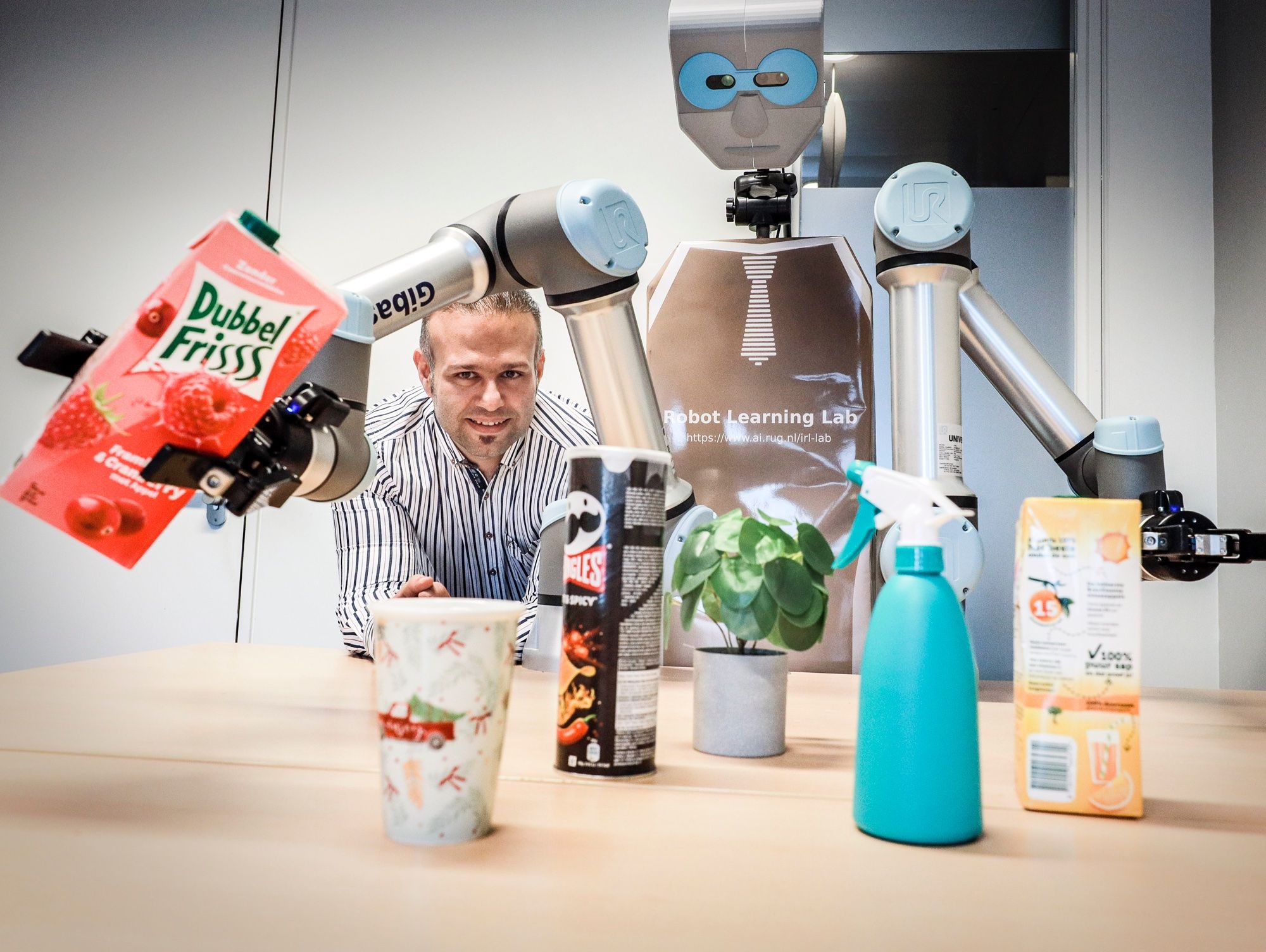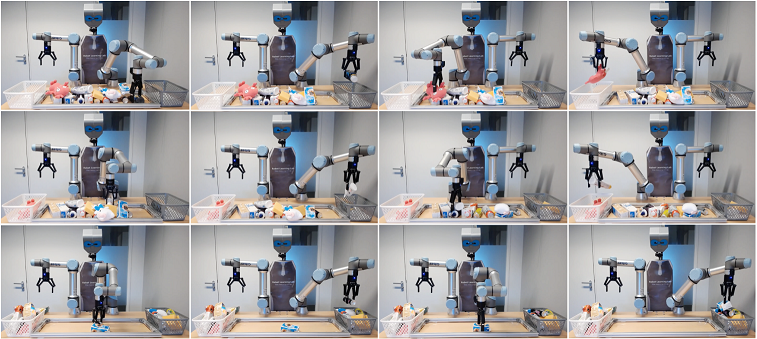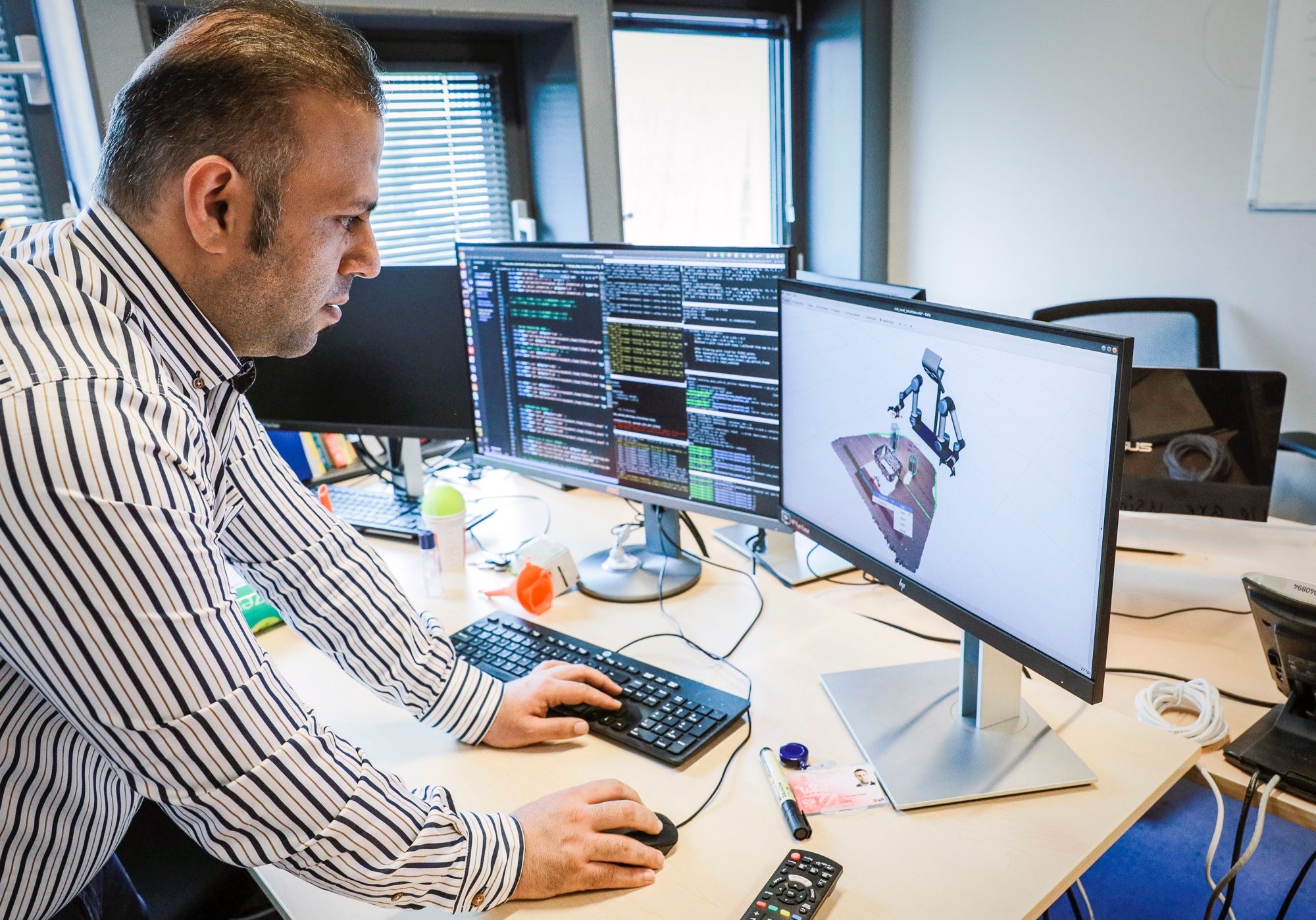A robot to do your cleaning? A very realistic scenario!

A robot that vacuums, clears up, and takes out the trash: people have been dreaming of it since the first robots were developed. For a long time, it mainly seemed to be a futuristic utopia but, according to robot researcher Hamidreza Kasaei, it is closer than we think. His robot research at the Bernoulli Institute of the Faculty of Science and Engineering contributes to its realization. For this, he received the Gratama Science Award during the Ceremony of Merits of the UG on 1 July 2022.
Text: Thomas Vos, Photos: Henk Veenstra
When you walk into Hamidreza Kasaei’s office, you immediately see a pile of cans, coffee mugs, and drink cartons. They are not evidence of a messy lifestyle though. Above the pile of garbage, two robotic arms are hanging with what is made to look like a face above them. Kasaei: ‘This is where we set up all kinds of test rigs.’ He shows us a series of videos demonstrating how the robot is not only able to clear rubbish but also to pour drinks.

Gratama Science Award
Kasaei is not an unfamiliar face within the UG. During this year’s Ceremony of Merits, he received the Gratama Science Award, intended for relatively young, active, and promising scientists who stand out for original and impactful research. He is also asked to talk about his research at conferences around the world. However, he has never lost sight of his motivation: to develop autonomously operating robots that help people.
Twin brother
As children, Kasaei and his twin brother played with robots in Iran, their home country. They did not lose interest in this hobby and they both went on to obtain a Bachelor's degree in Computer Science. Playing with robots now took on a different meaning: 'Together with students from various disciplines we made soccer robots that could play together. That was quite challenging. We often spent whole days working on them and trying to think of solutions for all the difficulties we encountered. But at one point we had six robots playing soccer on the field.'

Humanoid robots
These robots did not look like humans. Kasaei: ‘This was mainly about speed and interaction. The robots had wheels and the way they moved did not resemble human movement.’ It was the latter that really attracted Kasaei, who, during and after his Master's degree in Artificial Intelligence, threw himself completely into the study of humanoid robots. For his PhD, he went to Portugal, where he was part of a project that designed robots for use in the hospitality industry, restaurants and so on: ‘This was completely different from making soccer robots. These robots must be able to act like people, recognize new situations, and perform a task on that basis. All that without us having to reprogramme the robot.'
Driven students
Prior to joining the University of Groningen, Kasaei was a visiting student at the Imperial Computer Vision and Learning lab of Imperial College London. He eventually ended up in Groningen, however, where his wife was already doing a PhD in genetics at the UMCG. He discovered that scientists were conducting research into autonomous robots at the Bernoulli Institute. Starting in the summer of 2018, he worked there as a postdoc for two years before becoming an assistant professor in 2021. Kasaei has no plans to leave Groningen: ‘I really like that I can teach as well as do research here. The level of both Master's and PhD students is very high. They are incredibly driven. We learn from each other and think with each other. That is exactly what you need in this type of research, which requires a lot of time and patience. Sometimes, a small broken or missing part can make everything go wrong.’ His love of teaching led him to develop his own course unit, Cognitive Robotics, which he now teaches to more than 100 students.
Adaptability
Kasaei's focus, however, remains research. He puts in dozens of hours a week. At the moment, that time is spent researching perception and imagination in robots. Kasaei: ‘I am trying to discover how we can incorporate a form of human perception and imagination into robots so that robots can perform actions autonomously, just like people, such as throwing away a drink carton. They also need to be able to do these actions in a changing environment or within a limited time frame. In other words, they need to learn adaptability, a trait we humans have as well.’
Lifelong learning
Kasaei is also looking into the possibilities of lifelong learning for robots. Kasaei: ‘At the moment, a robot often only has a number of primitive functionalities, such as moving and grasping something. But I want to see robots learning from people and from their experiences. For example, if I pour a glass of juice, a robot must be able to imitate this. In other words, it has to work in a self-thinking and self-learning way in order to function even better, without the user having to be an expert in the field of robotics.’
Testing
To test his ideas, Kasaei sets up a lot of test rigs and simulations. ‘This is the only way we can prepare robots for a human environment. If something goes wrong, we can still easily correct it,’ says Kasaei. All kinds of sensors ensure that the robot receives information and can act on it.
Household
Ultimately, however, the robots must really become part of our society, for example as an addition to the household. According to Kasaei, this offers many advantages: ‘For decades, humans have been dreaming of a robot that can do our laundry, cook, or clean up after us. And that is now coming within reach. This could save us hours every day, which we can spend on things we consider important.’
Other applications
However, other applications are also possible, according to Kasaei: ‘My research can bring major economic and societal benefits, ranging from agricultural robots for improving productivity to healthcare robots reducing the workload of the medical systems during a pandemic, and from educational robots as peer learners for children with learning difficulties to assistive robots helping people with motor impairment to gain independence in their daily lives.
‘I want to develop robots that can learn to help people live better lives, every day and everywhere’
'The ultimate vision for my research is to develop robots that can learn to help people live better lives, every day and everywhere. In the same way that personal computers have transformed our lives beyond our imagination, I believe personal robots can do the same and improve our lives in many ways we could never imagine.'
Trust
Kasaei emphasizes one key point: people need to start trusting robots. The idea of self-learning robots may bring to mind movies like I, Robot, in which a distrustful Will Smith saves the world from being taken over by authoritarian robots. According to Kasaei, however, there is no reason to be afraid. He imagines something like Wall-E, which features a small waste-cleaning robot: ‘Robots can also take over dangerous tasks from us. Above all, they can make our lives a lot easier.’ So, while we will probably not be living under the reign of an iron brain anytime soon, a robot will be able to pour you an ice-cold glass of beer in the near future. Not bad.
More information: Hamidreza Kasaei
More news
-
16 October 2025
Creating sustainable batteries to power the energy transition
-
15 October 2025
Night of the Night 2025
-
08 October 2025
Not all plastic needs to be bio-based or biodegradable
